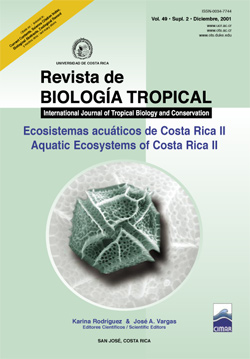Abstract
Superficial seawater temperature (SST) and at two depths (7 and 12 m) were measured non-continuously during the study of the corals and coral reefs of Culebra Bay (1993-1996). SST showed seasonal variations of ~4°C. The highest average temperatures (27.0 ± 0.1, range 23-29°C) were during the rainy season from May to November and the lowest (22.9 ± 0.3°C, 15.5-29°C) during the dry season from December to April. Cold fronts with 2-3°C differences in SST frequently pass into the bay and remain there for several hours according to the tidal cycles. Differences of ~3°C between SST and the bottom (5-10 m depth) were usually found, particularly at locations where bottom topography and tidal circulation produced tidal bores. The average temperatures recorded by data loggers placed at 7 and 12 m depth on a coral reef at the outer shores of Culebra Bay, were 27.1 ± 0.02ºC (20.5 – 31.6ºC) and 25.8 ± 0.04 (9.9-31.5ºC) respectively. The seasonal pattern of higher and lower temperatures corresponds respectively to the rainy and dry season of the northern Pacific coast of Costa Rica. Water temperature at 12 m was <14ºC for some hours during an upwelling event whilst minimum temperatures at 7 m were ≥ 22ºC. Negative temperature anomalies coincided with an increase of the NE-E winds intensity and there is a lunar and tidal component which influence diurnal variations of temperature. These results suggest that coral reefs built by branching species (e.g. Pocillopora spp.) in Culebra Bay could be limited by both the influence of cold fronts and by seasonal upwellings which affect negatively those coral species, as reported for other locations in the tropical eastern Pacific.References
Brenes, C., B. Kwiecinski, L. D’Croz & J. Cháves. 1995. Características oceanográficas de la plataforma Pacífica de América Central y aguas oceánicas adyacentes. PRADEPESCA, Panamá. 75 p.
Clarke, A. 1988. Inertial wind path and sea surface temperature patterns near the Gulf of Tehuantepec and Gulf of Papagayo. J. Geophys. Res. 93: 15491- 15501.
Dana, T. 1975. Development of contemporary eastern Pacific coral reefs. Mar. Biol. 33: 355-374.
Eakin, C., D. Smith, P. Glynn, L. D’Croz, & J. Gill. 1989. Extreme tidal exposures, cool upwelling, and coral mortality in the eastern Pacific (Panama). Proc. Assoc. Is. Mar. Lab. Carib., Puerto Rico, 22:29.
Fiedler, P., V. Philbrick & F. Chávez. 1991. Oceanic upwelling and productivity in the eastern tropical Pacific. Limnol. Oceanogr. 36: 1834-1850.
Gates, R., G. Baghdasarian, & L. Muscatine. 1992. Temperature stress causes host cell detachment in symbiotic cnidarians: implications for coral bleaching. Biol. Bull. 182:324-332.
Glynn, P. W. 1977. Coral growth in upwelling and nonupwelling areas off the Pacific coast of Panamá. J. Mar. Res. 35: 567-585.
Glynn, P. W. 1990. Coral mortality and disturbance to coral reefs in the tropical eastern Pacific, p. 55-126. In P. W. Glynn (ed.). Global Ecological Consequences of the 1982-83 El Niño-Southern Oscillation. Elsevier, Amsterdam.
Glynn, P. W. & L. D’Croz. 1990. Experimental evidence for high temperature stress as the cause of El Niñocoincident coral mortality. Coral Reefs 8: 181-191.
Glynn, P. W., E. Druffel & R. Dunbar. 1983. A dead Central American coral reef tract: possible link with the Little Ice Age. J. Mar. Res. 41: 605-637.
Glynn, P. W. & I. Macintyre. 1977. Growth rate and age of coral reefs on the Pacific coast of Panamá. Proc. 3rd. Int. Coral Reef Symp., Miami. 2: 251-259.
Glynn, P. W. & J. Maté. 1997. Field guide to the Pacific coral reefs of Panamá. Proc. 8th Int. Coral Reef Symp., Panamá 1: 145-166.
Glynn, P. W. & R. Steward. 1973. Distribution of coral reefs in the Pearl Islands (Gulf of Panamá) in relation to thermal conditions. Limnol. Oceanogr. 18: 367-379.
Guzmán, H. & J. Cortés. 1993. Arrecifes coralinos del Pacífico oriental tropical: revisión y perspectivas. Rev. Biol. Trop. 41: 535-557.
Hubbs, C. & R. Roden. 1964. Oceanography and marine life along the Pacific coast of Middle America, p. 143-186. In R. West (ed.). Handbook of Middle American Indians. Univ. Texas, Texas.
Jiménez, C. 1997. Corals and coral reefs of Culebra Bay, Pacific coast of Costa Rica: anarchy in the reef. Proc. 8th Int. Coral Reef Symp., Panamá 1: 329-334.
Jiménez, C. 1998. Arrecifes y comunidades coralinas de Bahía Culebra, Pacífico Norte de Costa Rica (Golfo de Papagayo). MSc Thesis, Univ. de Costa Rica, San Pedro. 218 p.
Jiménez, C. 2001. Arrecifes y ambientes coralinos de Bahía Culebra, Pacífico de Costa Rica: aspectos biológicos, económico-recreativos y de manejo. Rev. Biol. Trop. 49. Supl. 2: 215-231.
Le Fèvre, J. 1986. Aspects of the biology of frontal systems. Adv. Mar. Biol. 23: 163-296.
Legeckis, R. 1988. Upwelling off the Gulfs of Panamá and Papagayo in the tropical Pacific during March 1985. J. Geophys. Res. 93: 15489-15489.
McCreary, J., H. Lee & D. Enfield. 1989. The response of the coastal ocean to strong offshore winds: with application to circulations in the Gulfs of Tehuantepec and Papagayo. J. Mar. Res. 47: 81-109.
Pennings, S. 1997. Indirect interactions on coral reefs, p. 249-272. In C. Birkeland (ed.). Life and Death of Coral Reefs. Chapman & Hall, New York.
Pineda, J. 1991. Predictable upwelling and the shoreward transport of planktonic larvae by internal tidal bores. Science 253:548-550.
Richmond, R. 1990. The effects of the El Niño / Southern Oscillation on the dispersal of corals and other marine organisms, p. 127-140. In P. W. Glynn (ed.). Global Ecological Consequences of the 1982-83 El Niño- Southern Oscillation. Elsevier, Amsterdam.
Stumpf, H. & R. Legeckis. 1977. Satellite observations of mesoscale eddy dynamics in the eastern equatorial Pacific. J. Phys. Oceanogr. 7: 648-658.
Wolanski, E. & W. Hamner. 1988. Topographically controlled fronts in the ocean and their biological influence. Science 241:177-181.
##plugins.facebook.comentarios##

This work is licensed under a Creative Commons Attribution 4.0 International License.
Copyright (c) 2001 Revista de Biología Tropical


